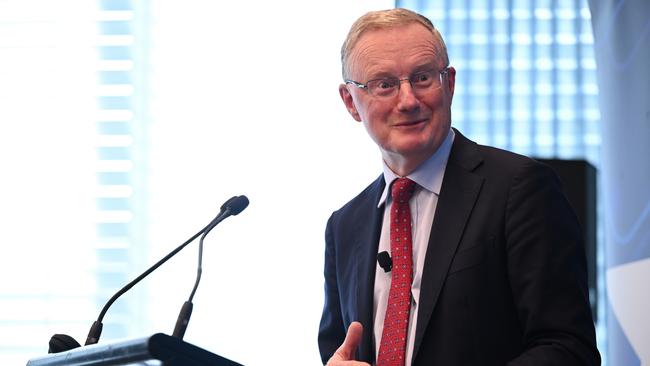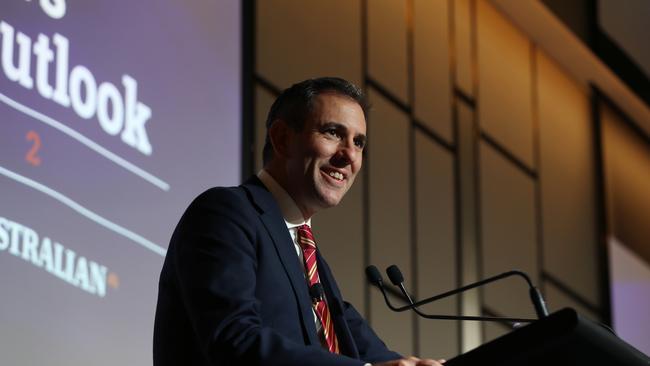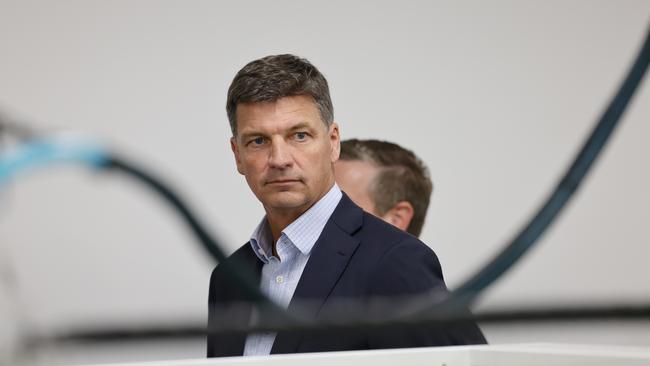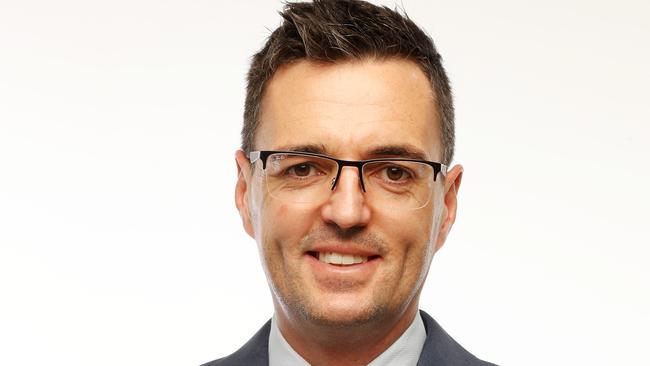Reserve Bank lifts official interest rates by 0.5 points to 1.35 per cent
Families such as the Sharmas are already paying hundreds of dollars extra each month on their mortgage and it’s set to get worse in August with a third consecutive 0.5 per cent rate increase expected.
NSW
Don't miss out on the headlines from NSW. Followed categories will be added to My News.
After the Reserve Bank of Australia jacked up interest rates by 0.5 percentage points in consecutive months for the first time on record, homeowners are being warned to brace for a three-peat in August.
The RBA raised its benchmark cash rate yesterday to 1.35 per cent from 0.85 per cent in a move set to add $216 a month to repayments on the average new home loan in NSW of $781,000.
The budgeting blow came as one of the biggest power retailers, EnergyAustralia, said it was hiking bills by $360 annually for the typical NSW household.
Treasurer Jim Chalmers said inflation pressures were coming “together at once in the worst possible way”, noting that grocery and fuel prices were also skyrocketing.
However, Dr Chalmers indicated the Albanese government was not preparing to deliver any additional cost of living relief and that the fuel tax cut would be allowed to expire in September.

He urged Australians to show resilience to get through the current economic pressures.
“I am confident that a better future and better days lay ahead, but first we need to show that characteristic Australian resilience to get through skyrocketing costs of living, and rising interest rates, and natural disasters, and all of this tricky combination of economic circumstances that we have to navigate together,” he said.
“There is no reason why we can’t emerge stronger from the difficulties … we confront.”
In a statement accompanying Tuesday’s rate increase, RBA governor Philip Lowe said the bank’s “board expects to take further steps in the process of normalising monetary conditions in Australia over the months ahead.
Nearly every leading economist had expected the RBA to lift by 50 basis points on Tuesday, following a 50bp jump in June and a 25bp bump in May – the first since 2010.
The RBA is now expected to complete a 50bp three-peat next month.
That would bring the cash rate to 1.85 per cent.
Nomura senior economist Andrew Ticehurst forecast the RBA would maintain its “aggression” in tackling inflation, which is expected to rise to seven per cent later this year.
The central bank wants to get that back to its target range of 2 to 3 per cent.
To do so will likely require raising the cash rate to somewhere in that range as well, which is considered the neutral level.
Mr Ticehurst said: “We think the RBA is like an Olympic sprinter, still with its head down in the first part of the race, and with a determination to move rapidly to at least neutral policy settings before it looks up.

“We think a cash rate of 2.35 per cent is broadly neutral, and it would take a major shock to stop (the RBA) from achieving this”.
However, that is a full percentage point above the current cash rate.
A series of further increases adding to that amount would load another $449 onto repayments of that average new mortgage, bringing monthly instalments to a hefty $4686.
In a statement accompanying the latest hike, RBA governor Philip Lowe indicated the central bank board was far from done.
“The board expects to take further steps in the process of normalising monetary conditions in Australia over the months ahead,” Dr Lowe said.
“The size and timing of future interest rate increases will be guided by the incoming data and the board’s assessment of the outlook for inflation and the labour market.
“The board is committed to doing what is necessary to ensure that inflation in Australia returns to target over time,” Dr Lowe said.

Australian Chamber of Commerce and Industry chief Andrew McKellar said the RBA was right to act quickly “given the recent rapid acceleration of inflationary pressures across the Australian economy.
“The process of increasing interest rates will trigger some pain as consumers and businesses face higher loan repayments. However, a failure to do so would only risk embedding high inflation, forcing the Reserve Bank to take more drastic action,” Mr McKellar said.
Dr Chalmers said he understood the reasons for the decision by the “independent Reserve”, but it was still tough news for “a lot of Australians”.
“We’ve got skyrocketing prices for groceries and petrol, electricity and many of the essentials for life, people are now having to contend with rising interest rates as well,” Dr Chalmers told Sky News.
“People are bracing themselves for a difficult period ahead as all of these inflation pressures … on household budgets come together at once in the worst possible way.”
He indicated there would not be any new financial relief in the October budget, which was already “constrained” by a “trillion dollars of debt”.

He also reiterated Labor’s position that it would allow the 24.3 cents a litre fuel tax cut to expire in September.
“It costs billions of dollars to extend it for six months, or even in a staggered way would be very costly,” Dr Chalmers said.
Opposition treasury spokesman Angus Taylor said Dr Chalmers needed to resist pressure from other Labor ministers to spend, putting pressure on interest rates and inflation. Mr Taylor said he doubted Dr Chalmers had the “seniority” to push back against some of his colleagues’ demands.
Saurabh and Roopali Sharma are feeling the pain of rising interest rates as they await the completion of their new home at Box Hill in northwest Sydney.
The pair have already seen a $600 increase in repayments on their mortgage – which covers the land and construction – and are bracing themselves for the latest hike.
“It’s really making it difficult for us to manage the monthly expenses,” Mr Sharma said.
“It’s already increased by $600 a month and we are expecting another $200 from the new increase.”
The couple, who share sons Sourish, 9, and three-month-old Sharvin, have faced construction delays due to Covid.
“It’s really difficult at the moment,” Mr Sharma said. “We are paying a mortgage while renting.”

ANALYSIS
John Rolfe
In a statement accompanying this latest cash rate hike, Governor Philip Lowe said “medium-term inflation expectations remain well anchored and it is important that this remains the case.”
What the Reserve Bank of Australia desperately wants to avoid is a situation where it becomes standard practice for businesses to simply pass on all their cost increases.
If that became the norm, the inflation rot would have set in.
High inflation is bad. Basket case economies of the world, like Turkey and Argentina, are plagued by spiralling prices. It used to be a major problem here too, with inflation averaging more than 10 per cent a year in the 1970s and 8 per cent in the 80s.
It’s currently on the way up to seven per cent – a level not seen for 20 years.
Rapid cost escalation is particularly harmful for people who don’t have the capacity to increase their income in response. That is, it hits strugglers hardest.
The good news is Australia’s current inflation problem is not as bad as what the UK and US are grappling with.
For starters, it hasn’t spread to wages like it has in those larger economies.

This is partly because many Australians who weren’t previously working have taken a job in recent times, pushing participation to record levels.
Those medium-term inflation expectations referred to by Dr Lowe show that among top economists the average expectation for inflation 12 months from now is 3.3 per cent.
The average among union officials – yes, such an index exists on the RBA website — is 4.4 per cent in a year’s time. Consumers say 6.7 per cent.
Most importantly, businesses expect inflation to be 3.6 per cent in June 2023.
If that turns out to be the case, Australia’s inflation problem will have been dealt with.
The RBA has now raised official interest rates by 1.25 percentage points since May as it bids to slow inflation by bringing demand back into line with constrained supply.
People with home loans should prepare for at least a further one percentage point of pain.
To get inflation back into the RBA target range of two to three per cent will probably take a cash rate of two to three per cent as well.




